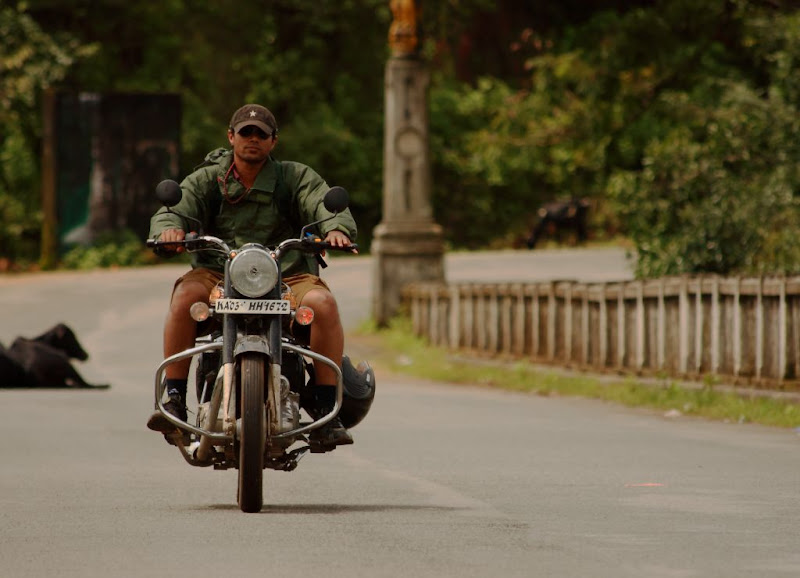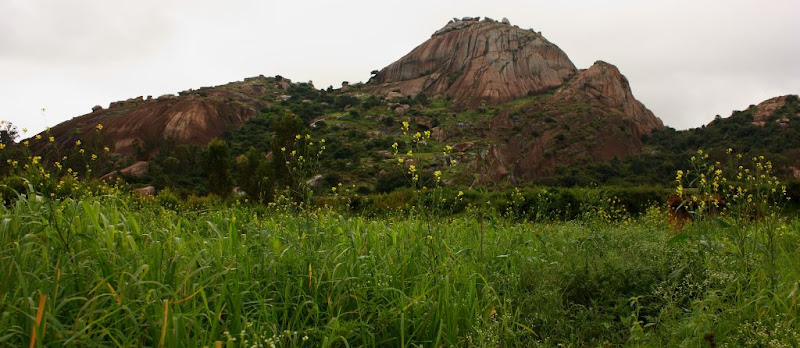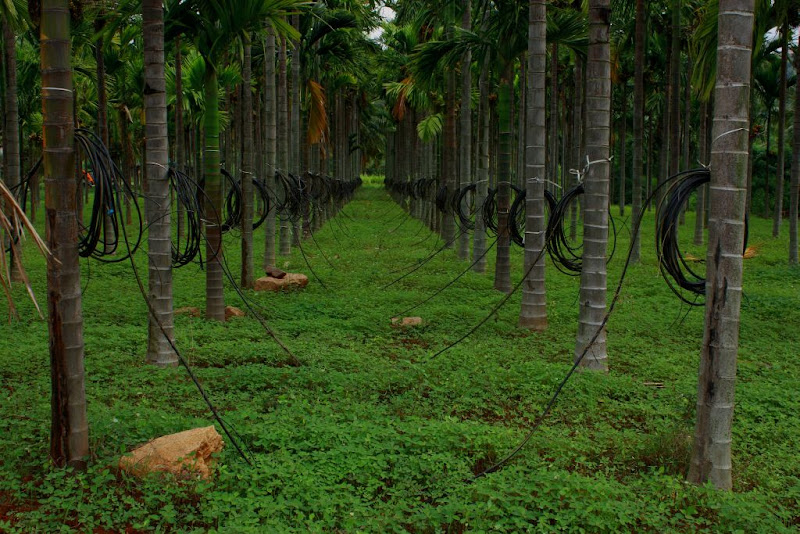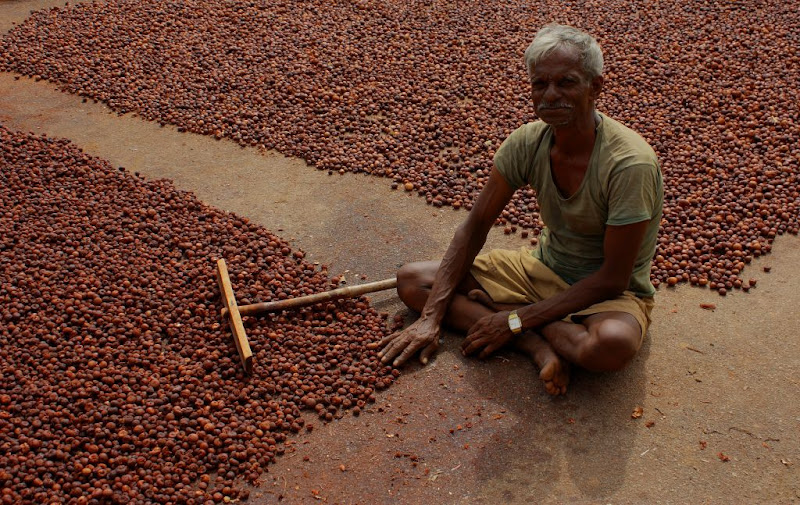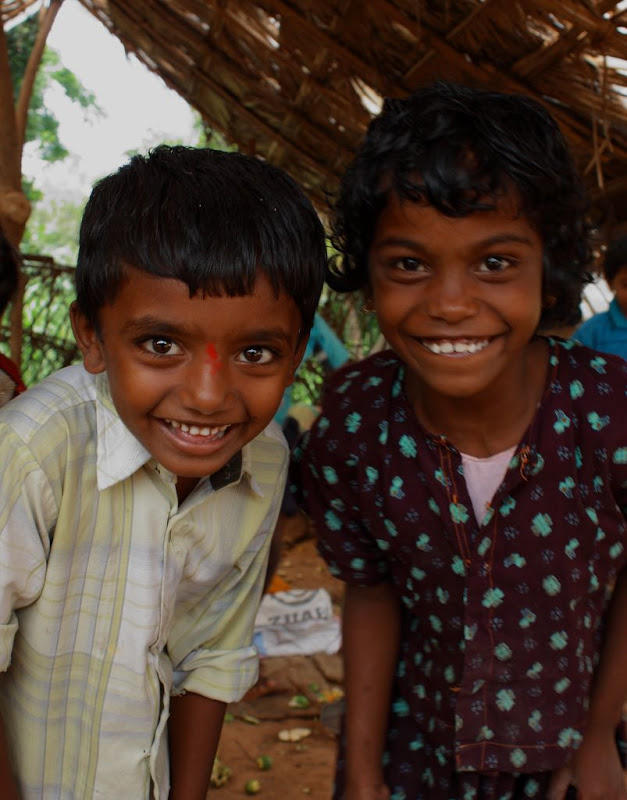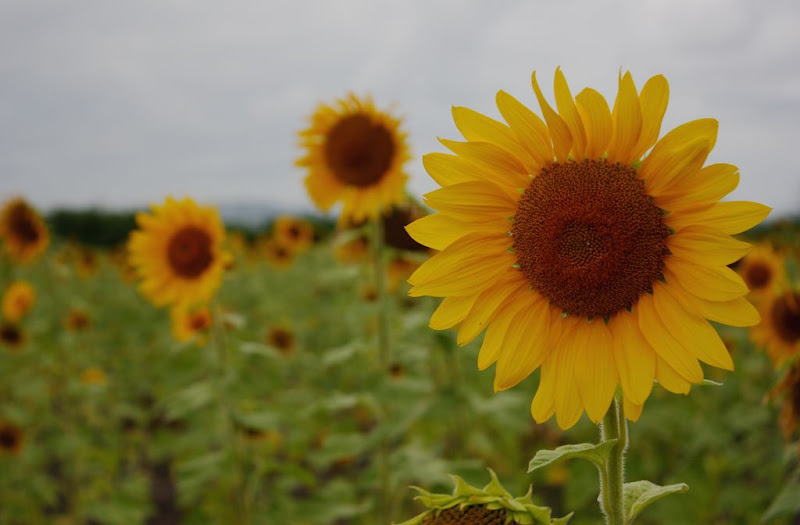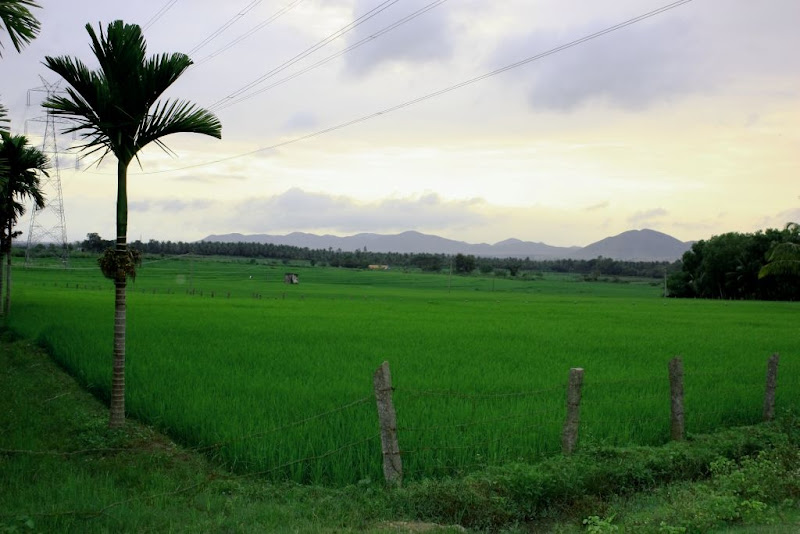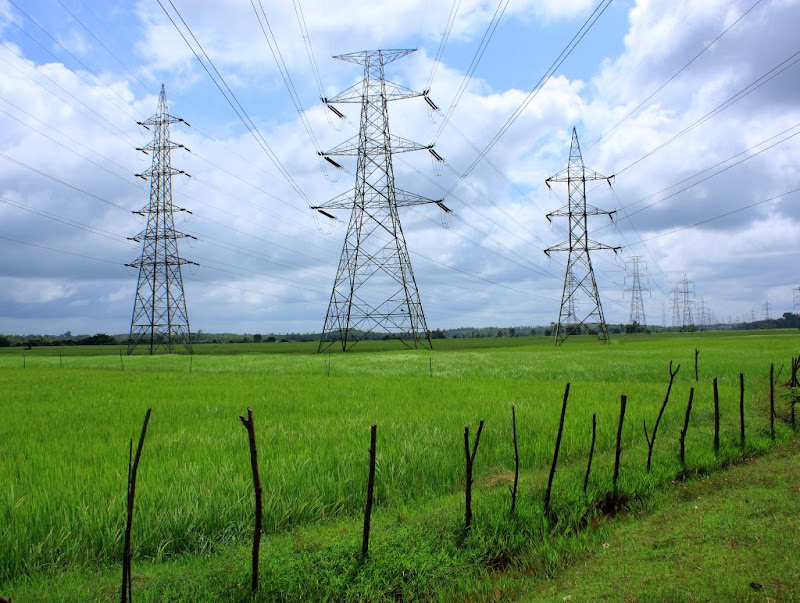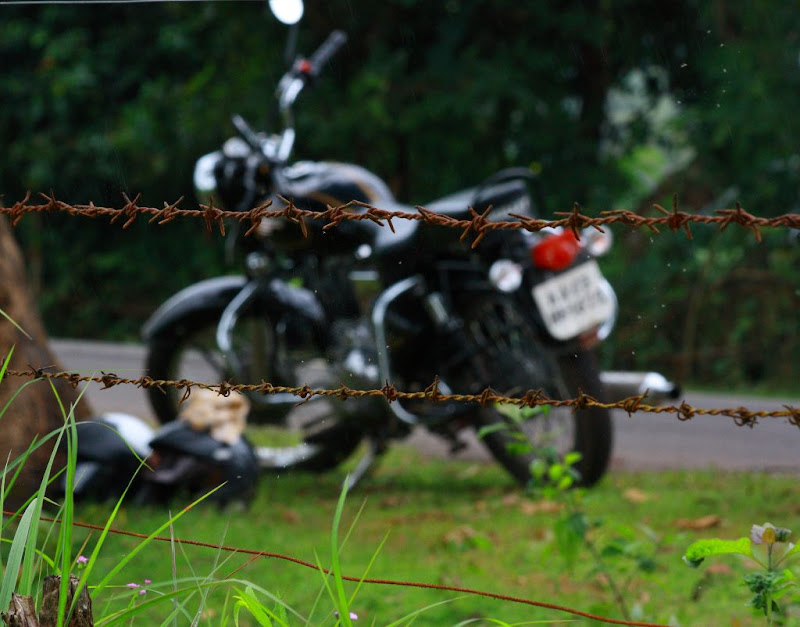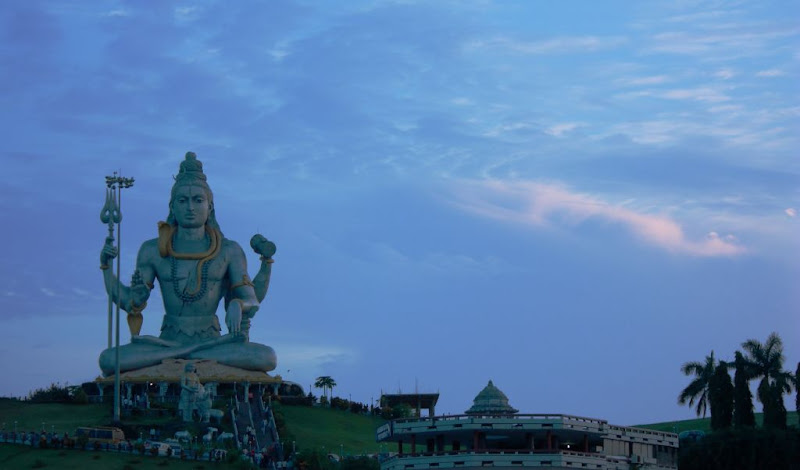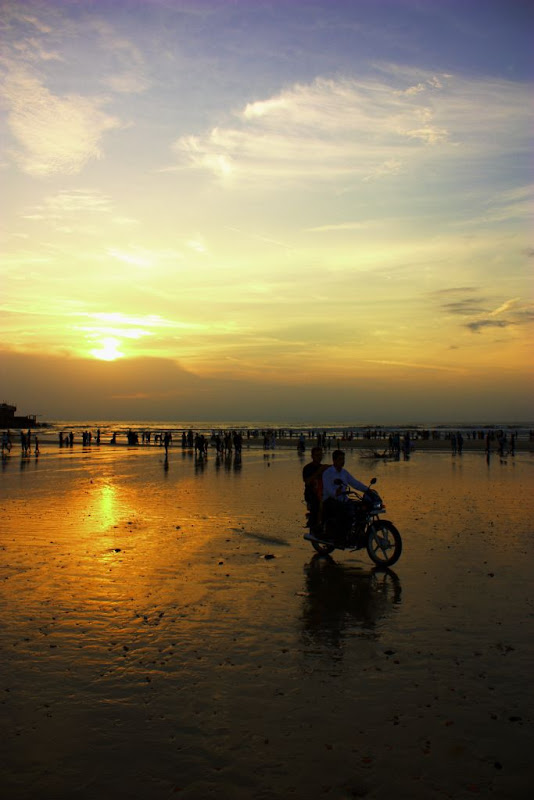Click on the image to view picasa web album ...
An impromptu decision may mostly always result in pleasant surprises, at least it well and truly did in this case. In this case it got me, who never have ridden a Royal Enfield Bullet before and who almost never believed he could kick start it, to drive one from the word go for a straight 1000+ kilometers over three days and in the process fall in love with it too.
On this second week of September 2010, as soon as the confusion cleared up and it was declared that Friday the 10th is a Holiday, I called up Ajin and said we'll go to Goa. He was more than game and even more so when I said we will go on his Bullet. But he had to leave for Chennai on Sunday night. Bangalore to Goa and back in less than three days on a bike seemed to be quite a bit of stretch. I still, nonetheless, went ahead with the plans. But Thursday saw the plans changing the destination to Murudeshwara, a pleasant beachhead along the west cost of Karnataka, and a much shorter target distance wise.
So Friday morning at 5.30 am Ajin came on his bull and with his friend Sanal on his Pulsar. As we were about to start, out of the blue he asked me to drive the bullet, saying something like there is dust in his eyes or so. I was more than reluctant, but yeah, right, impromptu, thought why not! I'm not sure if Ajin regrets the offer, but I never gave the handle bars back to him for the entire trip :-D
As Bangalore was slowly waking up to a holiday mood, we started out on the National Highway 4 to Tumkur. The plan was to reach Tumkur, proceed to Shimoga, to Sagar, visit Jog falls, to Honavar, Mrudeshwara and back. But plans are meant to be broken :-)
Not too far were we on our journey when a minor glitch happened. Me, a real novice, did not really know how to control this massively powerful beast machine that well. We were stopping by the road side to check something, there was some loose sand on the road, and as the whole thing was about to come to a standstill I think I went slightly aggressive on the breaks and the horizon suddenly tilted. I saw that the bike was skidding and falling. We, me and Sanal who was sitting behind, both fell to the side, at almost 0 kmph. Thankfully nothing much happened, and I blatantly refused to get off the handle bars :-) and we resumed the journey shortly after.
So as the sun was slowly rising further up in the skies, it found us cruising blissfully on the golden quadrilateral expressway to Pune. This road mostly makes an amazing straight line disappearing into nothingness far far away. There was not much of traffic, save a few trucks coming to sight at the horizon occasionally and gliding past us in some minutes. I was sort of overwhelmed by the feeling the Bullet evoked. The continuous thudding beat and the direct sensation on my palms reminding me of the massive power growling in the engines below. I guess most Bullet owners refer to it as bull, maybe assigning some sort of male characteristics to it. I, on the other hand, prefer to think of her as a girl, not even a lady, a girl, as wild as the wind and fire. Not a usual girl, but a girl with some much deeper might, that you can't take chances with her, still someone with whom you can gloat in complete harmony once you know how to handle her. A teenage lioness maybe?
We stopped on the way at the foot of a small hill. There was a mustard field by the side of the road, but there was no apparent way to enter the field. It was separated from the road by a trench covered with shrubs. I could finally figure out a way to squeeze in after scouting around it for sometime and it was kind of worthwhile. I spent some time with my canon inside the 'deserted' field.
Crossing the road there was an areca nut plantation. This was a peculiar sight. On one row of trees, all of them were strapped with some contraption looking like a coil of TV cabling. I could not figure what it meant. In a short while, intrigued by some random guys encroaching his farm and pointing cameras at various places a farmer came up to inquire what is happening. He seemed to be under the impression that we were from highway management authority and were taking pictures of parts of his farm next to be taken away for the highway! Once that was cleared up he kindly explained that the wired contraptions were for drip irrigation!
Somewhere further on the road, we again stopped by the roadside where people were drying areca nuts. I went and chatted with the aged man who was spreading the nuts. He said they sell it in Tumkur and get Rs 14000 per quintal, which was not bad. Taking a fancy to me wielding the camera over the nuts spread out to dry, they invited me to a shed by the roadside, where they were grading the nuts. Another weird contraption sat there, a big boiling cauldron, straight out of a magician's dungeon. Nuts were being boiled to get rid of the brownish color. There were lot of kids there, on a holiday today from school. They asked me to take their snaps and show it to them and I happily obliged. Soon they were all over me, laughing and pushing, enacting various poses, making me take snaps, and they'll come running and then burst out laughing looking at the snaps. I was thus drowned in laughter for quite sometime. My friends sitting at the road side thought I was being boiled in the cauldron for offending the farmers!
We reached Tumkur around 11.30 am or so. My friend had warned me of missing the highway exit to Shimoga. As we were getting over a fly over we saw a road sign on the road below showing Shimoga 210 Km off to the left. Confused we asked a moped guy on the flyover. He confidently said you can go to Shimoga if you continue straight on this highway itself! We were more than happy not having to turn around and continued on the highway! This turned out to be a defining moment of the trip! While the guy was probably right, when coming back we found out that there was a small deviation to the Shimoga road right after the fly over ends, but we naturally missed it now.
Thus we were en route to Pune looking for Shimoga. But I can't say I ever really regretted this decision anyway. Riding on this highway was pure pleasure. It was almost absolutely empty. The sun was bright and cool. The skies were a dazzling blue, dotted with puffy white clouds. Moreover, I had successfully established a good relationship with the lioness and she was happily purring under my caresses.
We were expecting that anytime we will come up against a big intersection with sign boards indicating take left for Shimoga. But that was not to happen. In fact we missed various deviations we could taken to get back to the original route. I was not complaining, except that our plans of exploring Jog falls today seemed to be already jeopardized. Finally after talking to numerous soothe sayers we decided to take the exit to Hiriyur, had some tea on the small market at the intersection and entered Hiriyur town. The auto drivers in Hiriyur told us that the road to Shimoga from there is really bad and advised to continue on the highway till Chitradurga and go from there. So we got back on to the highway and went on.
Soon we hit upon some sunflower fields, an obvious spot to stop and wield umm, the canon :-). Half past noon the flowers were already sort of drooped, but yeah! I have never been on a sunflower field before! This was the right kind of setting for something I was searching for over some years now. Theres a Malayalam song that has some lines that go like

meaning - "like two butterflies searching for flower fields". I wanted a snap for this line, to make something like this for that song. The flower field was here, I just needed the two butterflies and make them pose for me! I think I spotted two, for a second, or maybe I was hallucinating, they were never to be found again after that. I did find one lazy guy or girl? flying around quietly after sometime. Maybe she ate him after mating!!! Do flies do that?
Continuing on the highway we rode towards Chitradurga. There were some vast fields of windmills by the side of the road on distant hills. The wind here was very strong indeed. As we neared Chitradugra the highway was turning at the foot of a hill. There were two old windmills on that hill. They looked huge from that nearby. Riding on towards them I felt like Don Quixote, mounted on his aging horse and charging at the giant monsters!
Chitradurga provided us with lunch, and a dusty ride through a buzzing town. We dropped the idea of visiting the Chitradurga fort, hoping we could at least get to Sagar before night. Bidding adieu to durga we entered NH13 to Shimoga from there. Though it is termed a national highway, its a small two line road, with no dividers, going through lot of farming villages full of corn fields and areca nut plantations. This stretch from Chitradurga to Shimoga was on of the most appealing parts of the trip.
The road meandered though endless corn fields glistened by the afternoon sun. Once in a while some country bus services blasted past kicking up lot of dust on their path. We slept under a tamarind tree by the roadside when we were tired. The bikes were thankfully accustomed to being two tyred :-D We had tea from a small hut shop in a village intersection. The old guy wondered why I could speak to him in Kannada while my two friends could not! We drank up all his tea in the hot flask, tea is served in minuscule glasses here! He offered to go to his house and make and bring fresh tea, but we were already running kind of late :-)
As the sun began to settle down for the day, a new kind of traffic started appearing on the road. While nearing each village, we encountered cows and oxen and sheep herds returning to the village for the night after grazing along roadside grass fields. I had to exert strong control over the lioness to keep her from biting off a beef leg or two. We stopped by a large canal from the Badra reservoir and freshened up a bit. It was already 5.30 in the evening and I felt that we would have to halt at Shimoga today.
Sometime later, Ajin noticed a slight aberration in the beat of the Bullet. Inspecting further we figured out that the gasket around the silencer housing had come off. Probably it was an effect of the fall. This posed a hurdle. We needed to fix this at Shimoga. Seeing us crowding around the bullet, one guy came in a moped towards us and said he's a mechanic and that he can fix the gasket if we went with him to his village. So we followed him. He got off the main road and took us through some narrow country roads, lined on both sides by exuberantly green paddy fields. When it was not paddy fields, it was rows of old houses and wildly colorful free ranging chicken on the road. Finally he stopped in front of a house which turned out to be his. He went in and came out with nuts and some tools and fixed the gasket. The sound of the beat was better now, but he said we had to replace a washer that had gone bad to get back the original sound. So we decided to scout for a bullet mechanic after reaching Shimoga.
We reached Shimoga half past six in the evening. The town was very much crowded with people coming out in droves to shop for the Ganesh Chathurthi festival tomorrow. We asked many people - auto drivers, automobile spare parts shop guys, guys at some work shops - about any bullet mechanic. Finally one guy directed us to Bullet Mechanic Venu. After beating around many roundabouts through thick crowds, we finally spotted the Bullet garage. The mechanic was Murugan not Venu though.
Quick Gun Murugun was a typical Bullet mechanic. These guys are like little feudal lords in their own setup, with a bunch of assistants - the chotas in the workshop. He soon set to work. He fixes a little bend in the handle with some kicks and a soft hammer. He sits on a short stool near the bullet and extends his hand to thin air. One chota places a tool in his hand. He undoes the nuts the village mechanic had fixed. He extends his hand again into thin air and mumbles something. A chota replaces the tool with something else. He looked like a specialized surgeon performing a complex operation, the chotas replacing the surgeon's scalpels whenever he extends his hands into thin air.
We had him fit front and rear crash guards also to the Bullet. The sound of the beat was back to normal. We were happy. He has happy that we gave him a good tip over what he asked. He directed us to a good place to stay for the night. It was already 9.00 pm. After dinner we slept in deep dark oblivion.
Morning we started at 5.00 am and took the road from Shimoga to Sagar. It was still dark around. We stopped at the first teashop that opened and drank some fuel. It was very pleasant to ride as the morning was waking up. On the way we had couple of short stops, which mostly saw me trying to impart photography gyan to Sanal. This empty road was in stark difference to what we will experience while coming back on this during the day when it had lots of vehicular traffic. Sagar gave us brake fast and fuel for the bikes and set us on course to Jog falls.
Some constant companions to our trip after we left Shimoga were the massive high tension towers carrying the power lines from the Badhra dam power project. Sometimes they stood like rows of faithful sentinels along the side of the road towering into the grey morning sky. Sometimes as we descended into lower planes we could see them making criss crossing patterns across the land in a fractal geometry; splitting huge trunks into branches, the branches to twigs, the twigs to leaves and then running out of sight to far away lands. Once we stopped near a mini forest of Acacia trees. A smaller tributary of the power grid was passing right overhead here. I stood on the grass patch under the electric line and was focusing my camera at the trees. The road was devoid of any vehicles. All was silent in the world. Standing underneath this power tributary I had a queer sensation, there was a constant buzz in the air, like a swarm of bees. I looked up and realized that it was coming from the power lines. An invisible humming. All those electrons surging through like a swarm of bees along the wires. It had me spellbound and frozen like a statue for sometime.
Ghat section of roads began soon after. Driving the bullet through ghat sections was another experience. With its massive body combined with two people riding, the momentum this beast acquires is too huge and you can't expect to really curb it quickly if you go fast, plus I had learned my lesson from the skid in the beginning. But we did not encounter any problem and had a nice ride and hit Jog falls eventually.
I had been to Jog before, long long back, at a time when it was rather dry. I remember trekking down through a slippery hillock into the gorge where the fall descends and spending hours in the gorge at the bottom of the falls sitting under the spraying water droplets. Parking the bike I got down from it and climbed on to the culverts overlooking the gorge. I could not keep me from smiling rather stupidly. It felt like meeting and old friend. A friend who was not doing that well when you used to know her. But now she has done well and is doing really good. Jog was gushing in almost a full flow and she was simply beautiful. I am not ashamed to smile in situations like this :-)
The Jog management authority has constructed a flight of steps now, all the way down to the falls bottom. I don't really know if its a good thing or bad thing. We went down the steps to the bottom. Its a drop of about one and a half kilometers down. There were lots of people, this being a holiday. We spent about an hour or so at the bottom, me mostly sitting on a high rock and looking at the spray, not wanting to wade through the populace.
Climbing down and up all those stairs did not go down well with the light sprain I had sustained on my feet from the fall yesterday. But I did not find it a deterrent enough to get me off the handle bars. It was around 2.30 pm when we started from Jog to Honaver. Soon after Jog, we passed through a forest department check post which marked the beginning of some of the most testing stretches of roads we encountered. Ghat sections, completely winding downwards, almost 360 degree hairpins and some of them ending in gaping pot holes where once road used to be.
Making the lioness go easy on these slopes was another game. Probably it might be apt to say that she took on more of bull characteristics than that of an agile cat. She was all massive and powerful and charging; raring to tear down the slopes under the pull of her own weight and that of the two of us sitting atop. It was a long drawn out fight. Me holding on by the horns and using all my might to make her slow down, and she growling and fidgeting and trying to break free. I could not let her go, for beyond the next blind hairpin might lay a complicated pot hole system. Navigating some of them without finding yourself in the ditches was 'almost but not quite, entirely like' solving the travelling salesman problem. Probably if my mind was not too much preoccupied with the thoughts of what it means to be a control freak, I could have tried fashioning some proofs for P ≠ NP or otherwise out of this whole experience.
After fighting like that for couple of hours, we reached better roads and she was back to all cat. We made some quick time here aiming to hit the Murudeshara beach before sunset. We reached Honavar just after 5 pm in the evening. Its a typical coastal, fishing, port city that I usually instantly take a liking to. We passed through an unusually long bridge across the Sharvathi river. Riding the bullet on that bridge when the road is almost empty makes you feel transported to some imaginary world. Its all water and only water around, and in the distant horizons, all of it merges with the grey skies, in a broad continuum, with very little giveaways to tell you where water ends and sky begins, and in front of you stretches this grey patched road of asphalt and concrete extending to infinity.
We reached Murudeshwara after 6.00 pm. It was awfully crowded, the day being a combined burst of Ganesh Chathurthi and Eid. Moreover the universe blatantly refused to treat us with a breathtaking sunset; Like an over conservative bride, she pulled her thick cloud veils across her magnificent jewels and sat with a drooped head! We went to the beach nevertheless. It was nice and sultry and windy, the evening sea driving up constant surf and spray in to the air turning everything foggy. A towering, meditating, and impeccably calm Murudeshwara (Shiva) watched over the sea and the beach and the people, spreading a palpable aura of silence and peace and permanence. The night fell shortly. A thin crescent moon was born in the sky. The darkness was filled only with the sounds of the sea fondling the land playfully with a thousand of her fingers. We sat on the beach till it was very dark, till the surf started coming up and nipping at our backpacks which were comfortably lying on dry sand sometime back.
We had dinner at a beach side resort and checked into a hotel for the night and slept instantly. Sunday morning 6 O' Clock saw us getting ready and mounting the bikes for the return journey. We had a tight deadline to reach Bangalore by 7.oo pm or so. It was a long and tiring day. We retraced most our route, but this time we took the shorter route to Tumkur directly from Shimoga. We did not make as many stops compared to the onward journey, on one of which I tried to befriend a pet cat in a village chai shop, with little success though, she was probably scared by all foren guys suddenly interested in her. We were delayed by various things, a police patrol checking all bikes for most probably for a windfall loot in fines, bike running reserve and having to refill, and a huge traffic jam on Tumkur-Bangalore highway that permitted us to wash ashore in Bangalore only at around 10.30 pm in the night.
But I was very satisfied with the impromptu decision :-)
read more ...
